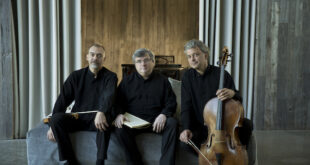A sound both ghostly and towering emerged from the rear of the tremendous house: The a cappella choir Artefact Ensemble had begun to sing. Led by Benedict Sheehan, the group performed a series of Orthodox chants as a prelude to the evening’s “main event” – Arvo Pärt’s Passio performed by the Experiential Orchestra with chorus and soloists under the baton of James Blachly.
From the rear, the Artefact singers moved to one side of the nave, and sang; crossed to the other, sang; and finished their program vocalizing directly at the audience from very far upstage (in what I think is called the narthex).
Unfinished as it is (and will likely remain), the Cathedral Church of St. John the Divine is the world’s largest Gothic cathedral. When music is presented here it is usually, and wisely, chosen to withstand the vast space’s sonic reverberation.
It should also be able to survive this hall’s psychological distance, which precludes the sense of intimacy that acousticians (and musicians) strive for in concert halls.
Music Ancient to Modern
The Cathedral is ideal for music like the Artefact Ensemble’s ancient polyphonic chants, where all voices, from soprano to basso profundo, move together and hold equal importance in the harmonies.
If anything, the middle voices stood out more than one usually hears in choral music – a very nice effect.

From start to finish the concert played out like a long and solemn ritual, resounding through the vastness of the cathedral. After an uncomfortably long interval – these hard seats are hard on backs! – the choir, instrumentalists, quartet of featured vocal soloists, and two major soloists – took the stage for Passio.
The Passion of Arvo Pärt
In this Passion setting by the ever-popular Arvo Pärt, bass-baritone Enrico Lagasca sang the role of Jesus from his own platform at stage right; tenor Haitham Haidar was Pilate from stage left.
Aside from some over-amplification of Lagasca’s voice, the overall sound was clear, all elements well balanced and distinct. In the Latin text, which derives from the Gospel of John, the quartet of vocal soloists play the part of the Evangelist. The full choir sings only occasionally – though here very beautifully, sometimes accompanied by a powerful church organ. I wished they had more to do.
Violin, cello, oboe and bassoon are the only other instruments. Pärt’s score makes their parts and those of the vocal quartet work together wonderfully.

This music is austere, beautiful, mesmerizing – up to a point. The problem with Passio is that it’s too much of the same, going on for too long.
Sure, it’s interesting to identify the variations Pärt introduces passage by passage. This instrumental figure consists of just two notes, that one four; this iteration of that vocal melody descends to something akin to a root, the last one didn’t.
But the key and tempo remain stubbornly consistent, as does the mood, with just occasional emergences of higher energy. Whatever else it may be, the Passion is a dramatic story. Pärt’s rendition is all solemnity, with very little – well – passion.

The performance itself was splendid. And it was an unqualified pleasure to hear Benedict Sheehan lead his own choir, the impeccable Artefact Ensemble, in music from the Orthodox tradition of which he is a leading scholar and interpreter.
When Concerts Take Themselves a Little Too Seriously
A final note: I was struck by the degree of ritualistic formality that enveloped the whole concert. Up to a point, this suited the music and the setting, as both are characterized by an earnest and exacting type of Judeo-Christian religiosity. But in excess, it collapses under the weight of its own seriousness. I’m afraid I couldn’t suppress a chuckle at the length of time Mr. Blachly took to finally, and ever so gently, lay down his baton after the last musical echoes had subsided.
Tension, tension, tension – and release. Well, I guess that’s largely what music is about, isn’t it?
 Blogcritics The critical lens on today's culture & entertainment
Blogcritics The critical lens on today's culture & entertainment




